This year has been a massive challenge for everyone. The global pandemic turned our lives on their head. I won’t be listing all the bad things here. It’s not the purpose of this post, plus there is nothing new I can tell you. Instead, let’s look on the bright side for a moment and appreciate all the colossal effort of the frontline heroes. 🧡
Since the COVID-19 crisis started, I bet we were all impressed by the courage and dedication of healthcare workers risking their lives to save ours. I also must admit my admiration to all the communication professionals that took up the challenge and were writing, recording, drawing, sharing, and updating those vital safety guidelines. This year, I learned that the one thing that can move faster than a deadly virus is information.
Sharing timely & accurate safety information during the pandemic saved (and is still saving) lives. Yet, I don’t feel that communication practitioners get enough credit for the crucial work they do every day. This blog post is my little contribution to change it. To make it more valuable, I reached out to eight internal comms professionals that work in major healthcare organizations to reflect together on the challenges, trends, and lessons of 2020. 👇
Clarity, Connectivity, Alignment
The communication ecosystem in healthcare organizations is complex. And by complex, I mean thousands of employees, dozens of roles scattered across many locations and different units, often also multiple languages and specific internal/external directions.
“Working for an organization in the healthcare field presents an added layer of complexity in terms of internal communications,” says Amy Sands Hadsock, Senior Director, News Channels at American Cancer Society. “Cancer patients face a much greater risk of becoming infected with COVID-19, so we need to be very proactive in our decision-making and communications to ensure the safety of cancer patients, caregivers, volunteers, and staff.
“Some of the impacts to our business have been the pausing of certain patient services and programs that pose a risk to cancer patients. Targeted communications have been extremely important to communicate about this type of change to the right audience and with repetition while not overwhelming our larger staff audience with unnecessary communications and details,” points out Hadsock.
Targeted and timely communication in such complex organizations is imperative. Everyone has been affected differently, and the one-size-fits-all approach to employee comms simply does not work. But before you proceed to targeting, you have to start with your objectives, suggests AMA Ambassador Engagement Director J. Mori Johnson. What is it that you are trying to achieve with a given campaign? This should be your first question, followed by ‘Who is your audience?’

“First, you have to know the goal of the information that you are trying to communicate,” says J. Mori Johnson. “What is the call to action? What is the best way to communicate that information and more importantly that specific call to action to your audience? It’s best to use the platform or medium that that specific audience is already using.
“COVID-19 accelerated our use of digital platforms that we were already using. The volume of information increased exponentially and the speed of delivering relevant information and resources had to become faster and faster. The most valuable lesson for me is to never forget who your audience is and if you tap into what they want, you can’t lose. When they need COVID-19 resources and the latest CDC information, deliver it fast, and communicate it effectively in a manner that your audience can take action.
💡 J. Mori shares an example of this kind of campaign: “At the beginning of the pandemic, physicians needed the latest information that they could share with their colleagues and patients. The information we relayed to them had to reflect the current information available and if the guidelines we shared were applicable to their patients we made sure to clearly call that out in the communication. We decided to create short videos to update our members (physicians) on the latest COVID-19 news and hear from their colleagues, fellow physicians, who were taking care of COVID-19 patients on the frontlines. We were producing these videos every day and using Smarp to convey the latest advocacy efforts related to COVID-19.”
📚 Read on: How Top Companies Are Using Smarp for COVID-19 Crisis Communications
Now, assuming you have all the ingredients for a successful comms campaign, there’s one more thing to consider — the framing. During the crisis, it’s essential to be able to cut the noise with clarity and consistency, suggests Stephanie J Ramos, Communications Manager, Mount Sinai Beth Israel:
“One valuable lesson from 2020 is that when the information is rapidly-changing and times are uncertain, communications, more than ever, need to have a structure and steady cadence. Simplify everything possible like timing, sender, outline, and design so that employees only have to process the information itself (which sometimes is vastly different than the day before). Employees were swamped and emotionally exhausted; sharing information in a predictable and digestible framework through one consistent voice will allow them to focus on their work. This is true beyond the crisis,” points out Ramos.
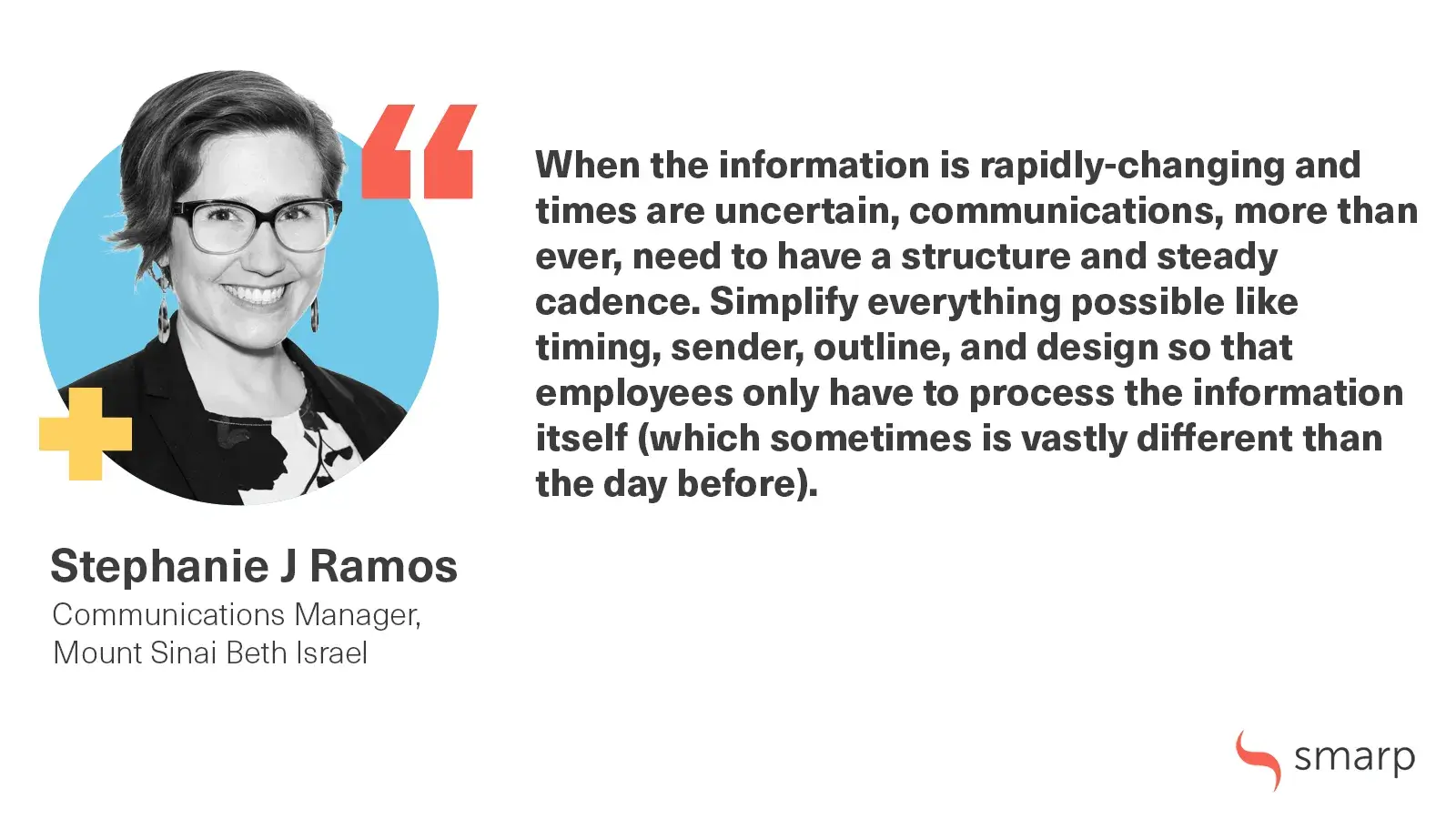
Reaching the Hard-to-Reach
The communication landscape in healthcare has always been complex. With the COVID-19 pandemic, additional layers of complexity were added on top: furloughed staff, employees working from home, doctors and nurses working long, exhausting shifts without access to screens. So how can we reach and engage our audience with relevant information?
“Communication in health care is like in any other field: get the right message to the right audience at the right time,” says Alan Flippen, Senior Director, Publications and Communications at Mount Sinai. “The challenge is in the “how” – how to reach many front-line caregivers who don’t sit at desks and rarely check their email, and many patients who don’t use email regularly or have opted out. So you need to develop other channels, including mobile apps and social media. And communications must be crafted with a particular audience in mind; scientifically trained doctors and nurses need a different approach than patients with at most a basic education.”
📚 Read on: 14 IC Experts Share Their #1 Tip to Engage a Distributed Workforce
Whitney Bania, Senior Communications Specialist at Benefis Health System, points out the important role of line-managers and supervisors when it comes to engaging a dispersed or hard-to-reach workforce. “Whenever possible, I tell supervisors an important email is coming before it goes out so they can be prepared when their staff receives it. I also offer to provide them with talking points, especially when the topic is sensitive.
“Healthcare comes with the challenge of engaging employees who are not always in front of their computers or in the habit of checking their work email. These factors require organizational teamwork in making sure relevant information gets to all the right people, and not just some of them,” says Bania.
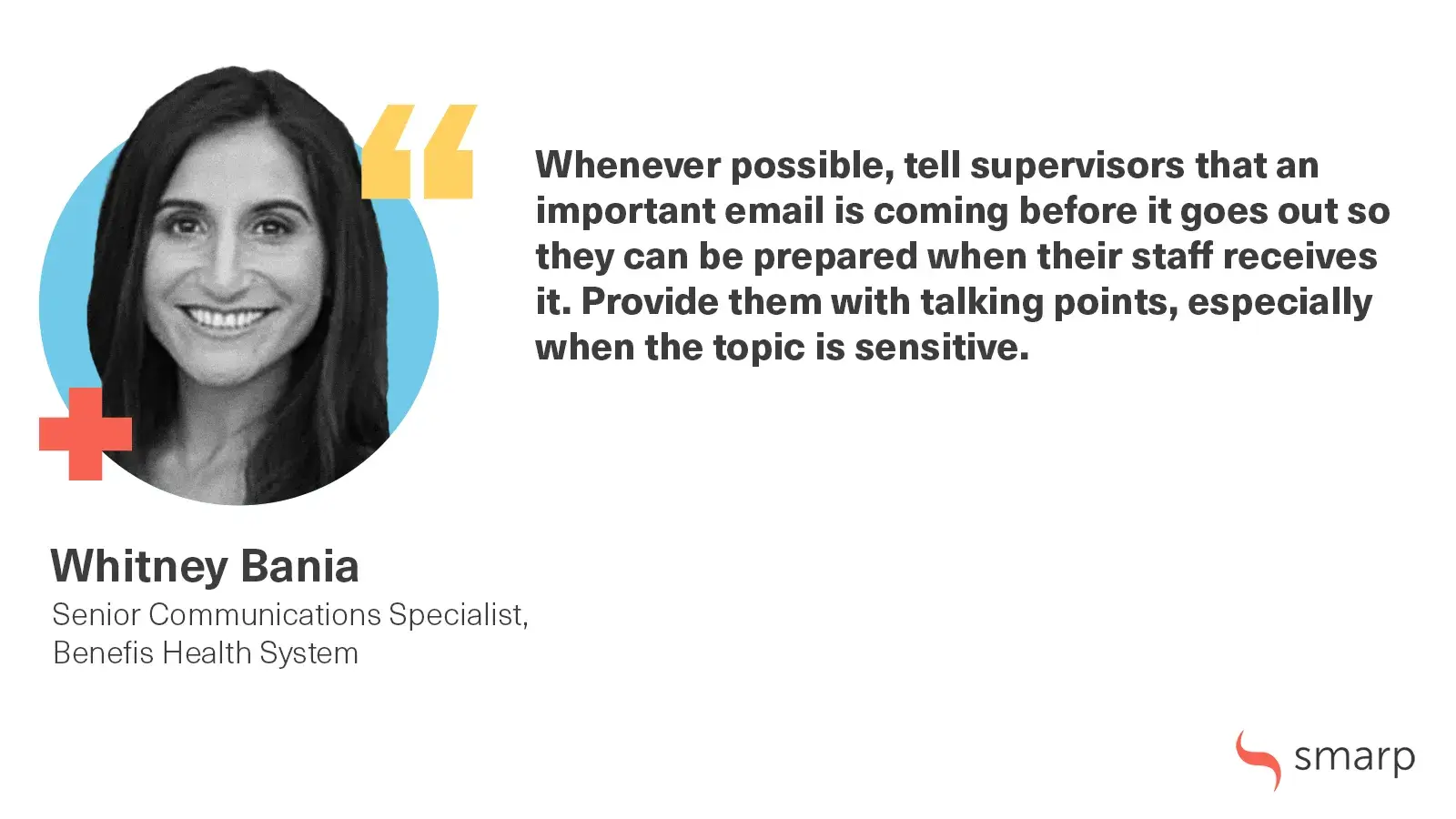
Human-Centered Approach to Communication
Studies done by Edelman Trust Barometer and Jarrard Phillips Cate & Hancock agree that people trust MDs, nurses, and hospitals the most. Healthcare providers have always been a critical and trusted source of information. During the pandemic, their authority and credibility have only strengthened.
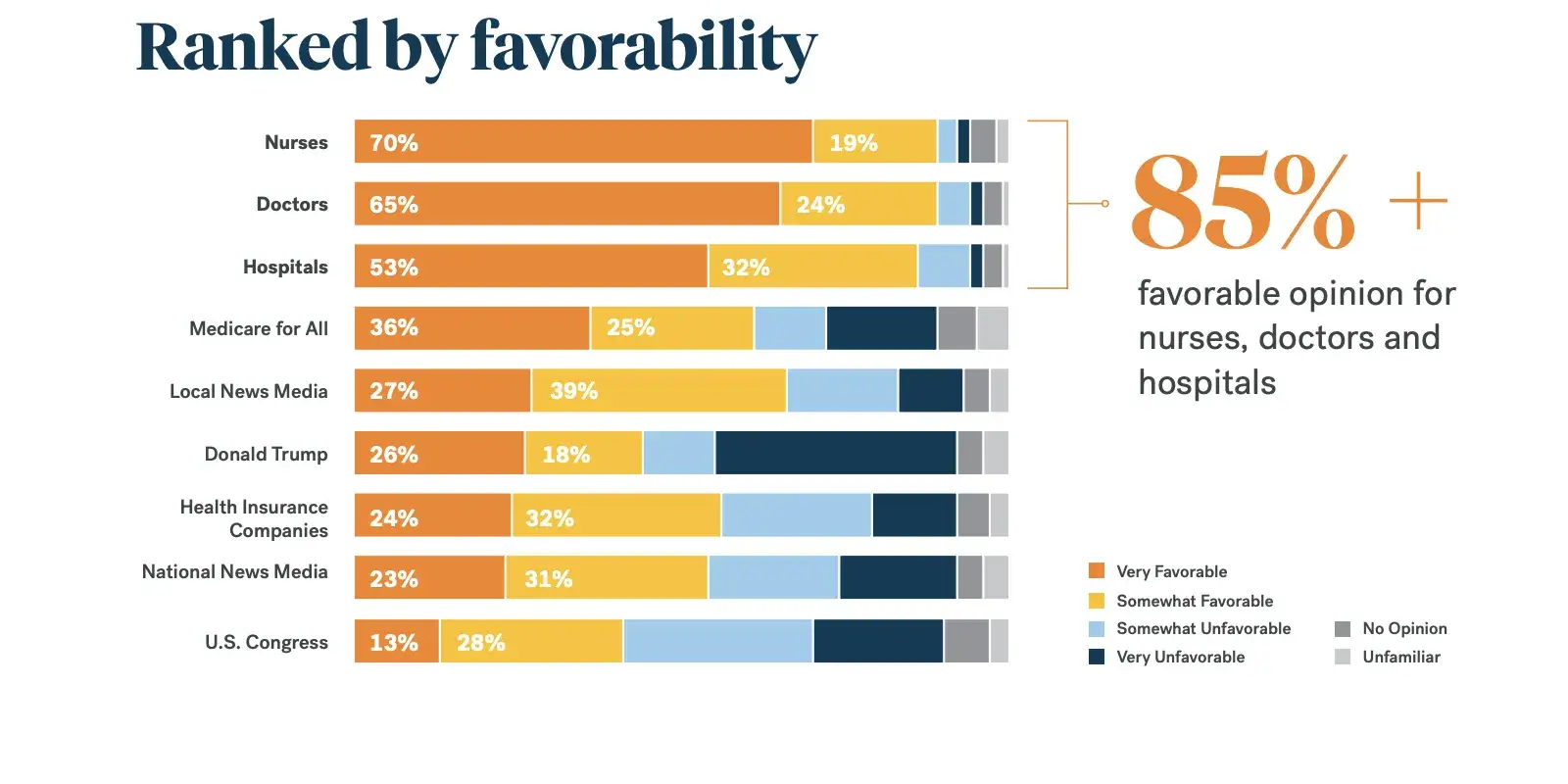
Image source: Jarrard Phillips Cate & Hancock
For healthcare organizations and their communication teams, in particular, this level of trust is an important asset that needs to be used responsibly. Alan Flippen, Senior Director, Publications and Communications at Mount Sinai, suggests that comms professionals should leverage targeting and personalization to utilize the full potential of trust.
“Flexibility, openness, and personal touch are essential. Messages from someone that the recipient knows and trusts – for staff, a particular leader; for patients, their own doctors – are key. They should be written in the first person, be honest and straightforward, and be delivered repeatedly through different channels to make sure they get through,” says Flippen.
“Treat employees as people first,” adds Emily L. Felmet, Communications Specialist II at BlueCross BlueShield of Western New York. “At the start of the pandemic, we changed course from our more corporate-style tone to address colleagues more comfortably, recognizing that everyone is a person facing their own obstacles during this trying time,” says Felmet.
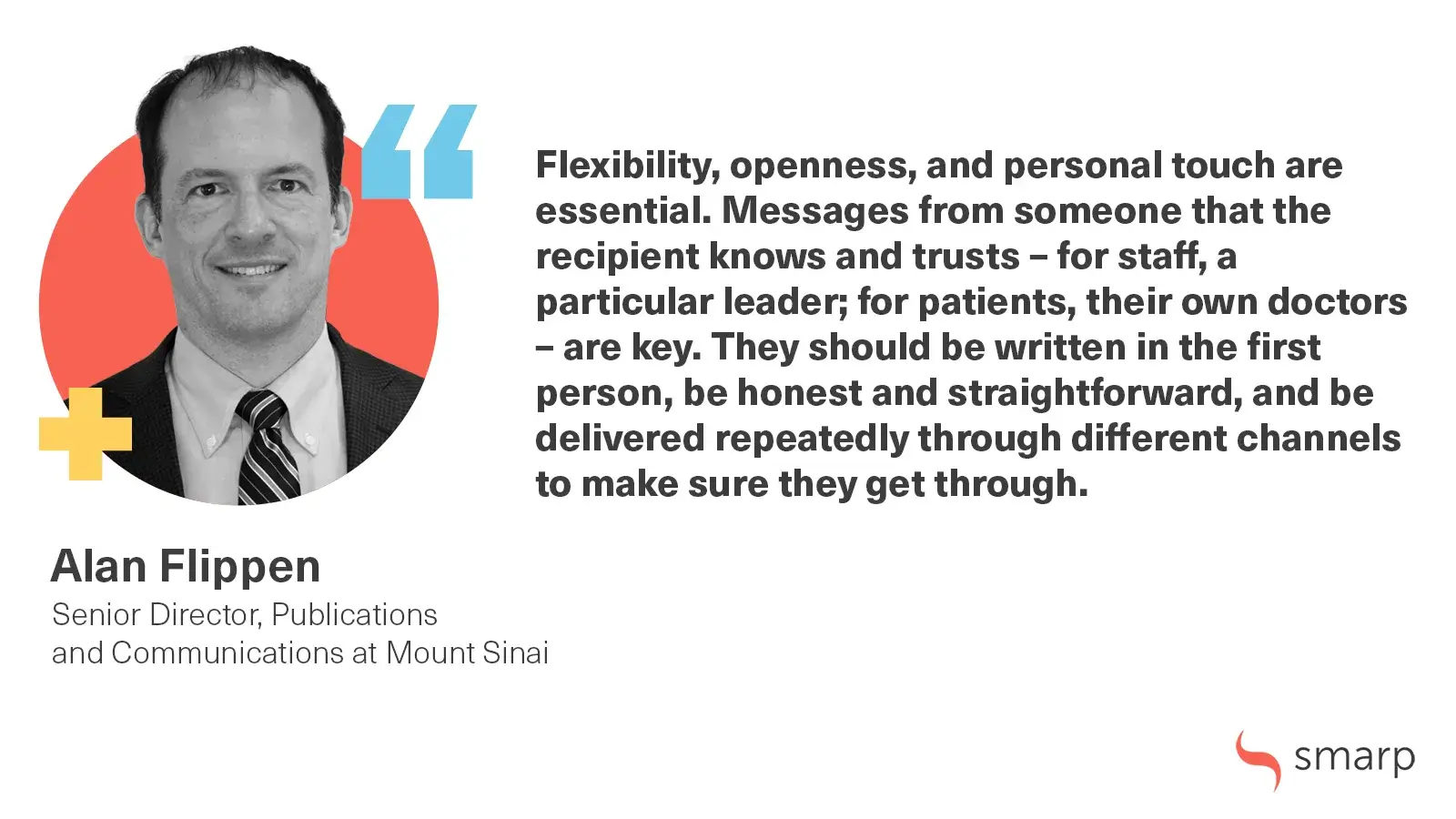
IT Coordinator Tiarra Lowery reminds us about the power of empathy in communication. “Empathy and Vulnerability are more important than ever. People want to talk to people. They want to laugh to keep from crying. They want honest expressions even if it’s to say I don’t know what’s going on or what’s happening tomorrow.
“I’m a private person, and I’ve found myself embracing and craving honest dialogues that require me to open up about my life, family, personal frustrations, and small wins that get me through the day. I’ve also found that my peers want to know what will help them de-stress at work, and they’ve challenged me to find new ways to be of service to them as they’re serving others,” says Lowery.

“Our members are burned out, Zoomed out, over-saturated with COVID-19 information so it’s even more important than ever to deliver content that is also personal, fun, social, and acknowledges the human being of your members,” stresses AMA Ambassador Engagement Director J. Mori Johnson. “Our members need to be able to take their minds off of the pandemic for a little bit in order to recharge and connect with their fellow physicians.
“To that end, we launched a Courageous Conversations series so they could come together on a regular basis to talk about their feelings and experiences within medicine and the pandemic as well as other personal experiences that need to be supported by other physicians who can relate and empathize. Don’t just focus on your business goals, serve your members, and give them what they need. If you don’t know what they need, just ask them,” says Johnson.
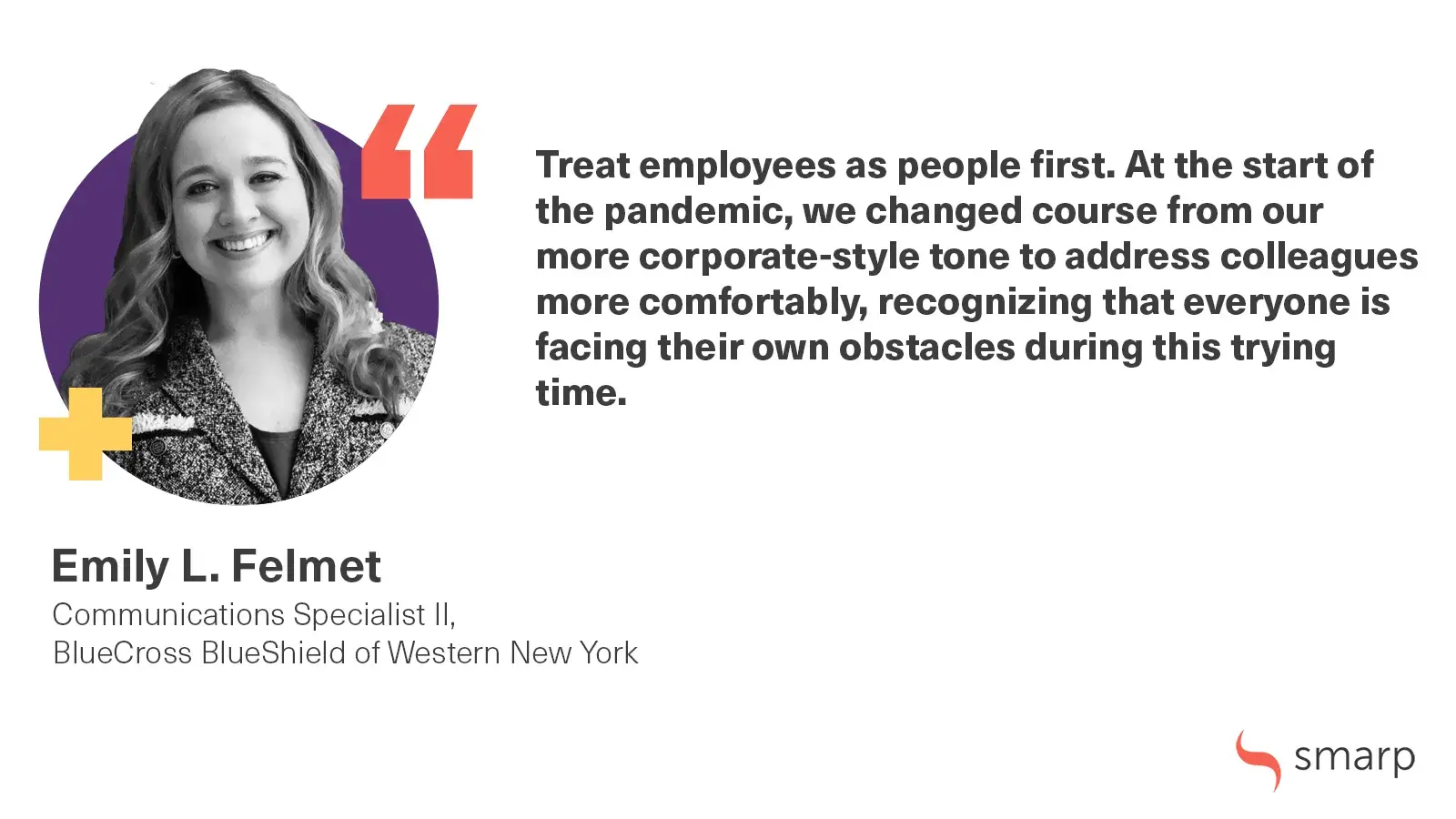
Employees’ Voice & Employee-Generated Content
It’s important to share leadership messages, without a doubt. But often we, as communication professionals, forget about the power of employees’ stories. Natasha Mitchell, Communications Specialist at Family & Children’s Services reminds us how important it is for IC practitioners to amplify employees’ voice in the workplace and beyond:
“An essential lesson learned is to incorporate the employees’ voice more into daily communication correspondence. It’s easy to focus on featuring and quoting leadership more often as they are the most accessible and visible. There are so many stories waiting to be told. We’ve all shared the common story about the challenges of balancing work and family remote life, grappling with COVID-19, seeking ways to meet clients’ needs, and finding activities that kept us occupied and hopefully stress-free. But then what? It helps to share common ground within the organization,” says Mitchell.
We mentioned above that people trust people. But credibility is not the only benefit of employee-focused and employee-generated communications. Practice shows that this type of comms drives more engagement and drives better results. “The content that received the greatest engagement is the content that featured our members or the topic was suggested by members,” shares AMA Ambassador Engagement Director J. Mori Johnson. “For example, our #MaskUp campaign came from our members who observed that their patients didn’t understand the importance of wearing a mask when outside of their home.”
📚 Read on: Internal Communications: the Shift Toward Two-Way Relationships
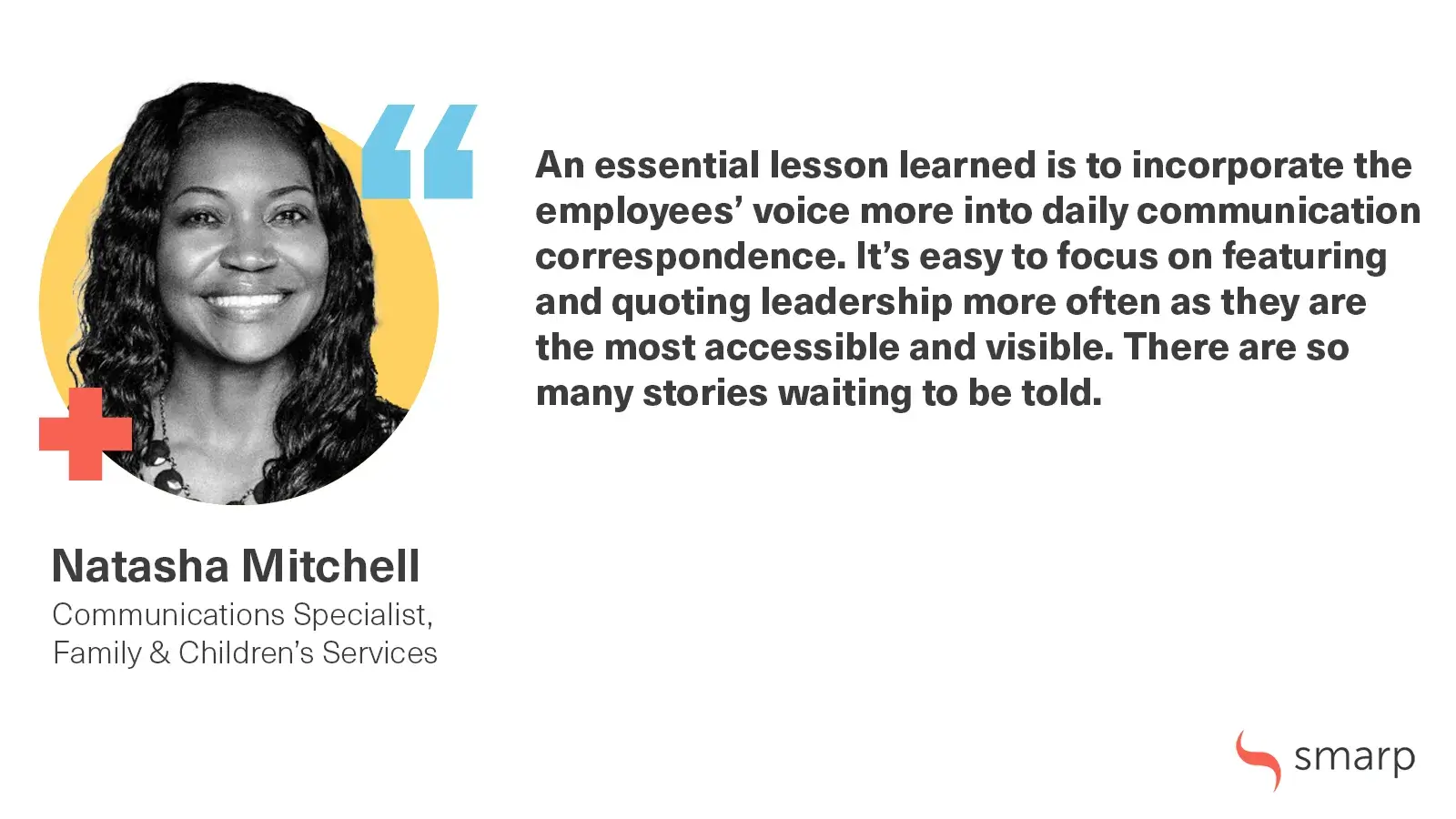
5 Tactics to Try
Newsletters vs. email overload
Email continues to be one of the employees’ preferred means of communication. As with any channel, if you overuse it, your audience will start to ignore you. So make sure that your messages are relevant, timely, and targeted. Consider sending one tailored roundup newsletter instead of several separate emails. Alan Flippen, Senior Director, Publications and Communications, says this approach works well at Mount Sinai. “We found that putting out what was, in effect, a daily newsletter was more effective than stand-alone emails. People looked forward to the updates arriving at the same time each day and in the same voice,” says Flippen.
Think mobile-first
Mobile is arguably the most inclusive medium at your disposal. Take a look at your comms strategy and your editorial calendar and check if all the touchpoints are mobile-friendly. From a comms platform that you use to distribute information — to content formats, its packaging and language. Will your audience, whether it’s a nurse, a cook, or a driver, get the optimal user experience when they get the latest update from you? If you want some inspiration, learn how the American Medical Association embraced mobile-first communications with Smarp in this customer story.

Videos-videos-videos
Short safety clips or extensive Q&A sessions; featuring leaders or front-line physicians & nurses; for internal or external use — there are so many ways to brighten up your comms with video. As was mentioned above, you want to make your comms human-centered. Sincere and honest videos are the perfect way to bring that human touch upfront. Most of the professionals I spoke to, use various video formats in their comms. If you’re not doing it, you are definitely missing out. It doesn’t have to be a Hollywood production, you don’t need to spend much money or time on it. A smartphone camera can work just fine as long as you define objectives, targeted audience, channels and content format.
Repetition and targeting are key
“There’s no such thing as over-communicating during major changes or a crisis – or in this case, a global pandemic – and repetition is key,” says Amy Sands Hadsock, Senior Director, News Channels at American Cancer Society. “To ensure your employees hear and retain your message, communicate frequently, use a variety of communications channels to reach everyone, and repeat your key messages several times. Without repletion, key messages tend to get lost or go unheard. Reinforcing key messages with repetition is also a great way to win over your internal critics. Our analytics showed a spike in staff engagement during COVID-19, telling us our staff were hungry for information and reading everything we communicated.”
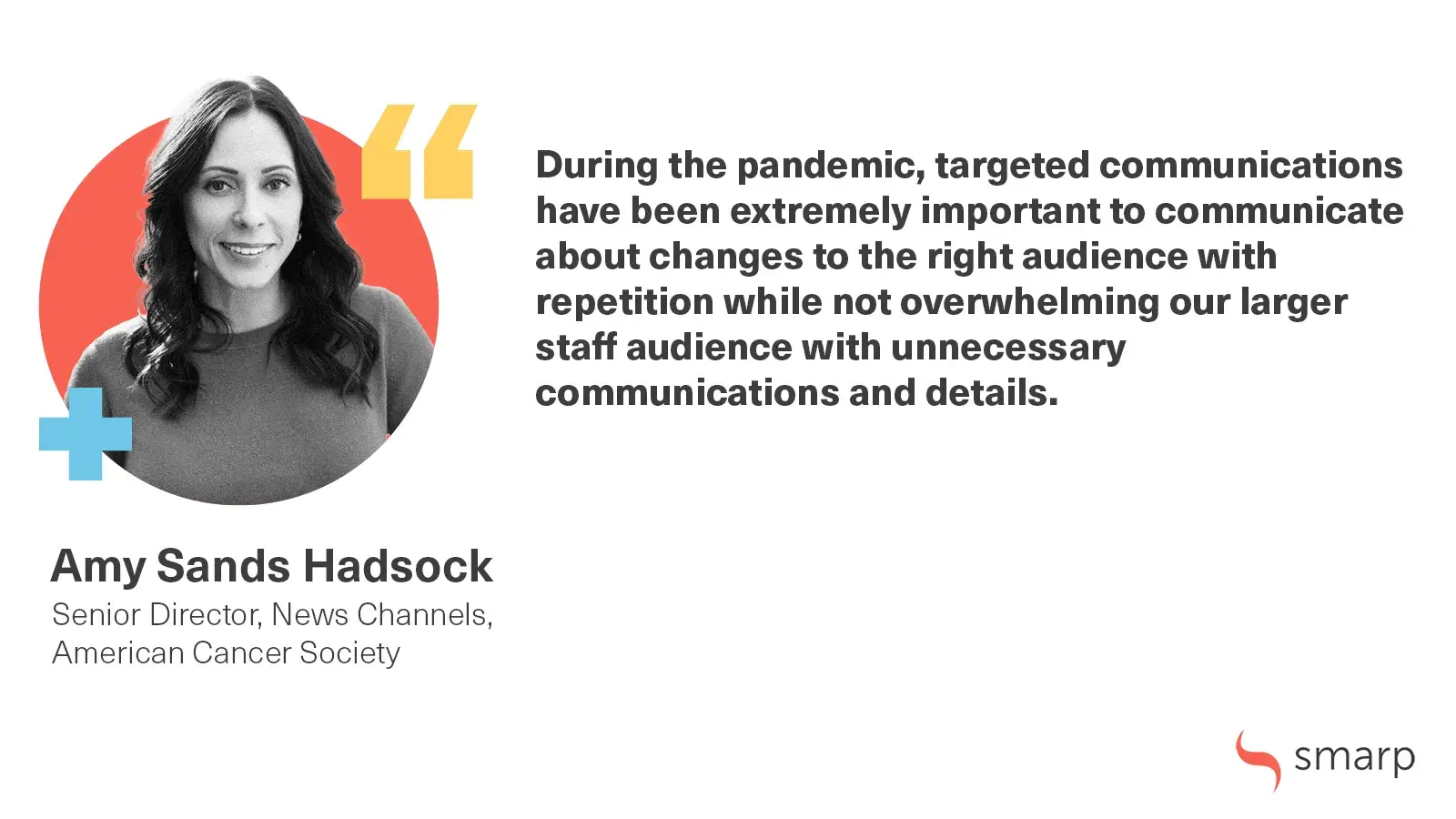
Don’t underestimate the power of posters
Print is far from dead. Many health practitioners simply don’t have time for or access to their screens. Wall posters or regular newspapers could be the solution. “Every daily update that our chief medical officer sent out during the crisis came with a printable summary, the “daily headlines,” which supervisors could print out and post on the walls of break rooms and work areas to reach those who couldn’t or wouldn’t check their emails,” says Senior Comms Director Alan Flippen.
Final Notes
First of all, I want to thank every contributor to this article for sharing their priceless lessons and advice! You all are doing a fantastic job, and I genuinely admire every comms professional who works in healthcare today! 🙌
Also, I want to thank you, the reader, for getting this far. I know it was a long read, but I hope you found some useful insights to take with you. If you’d like to talk more about this topic (or any other comm-related topic), I’ll be happy to connect with you on LinkedIn.









